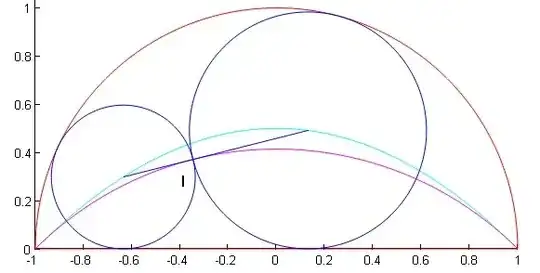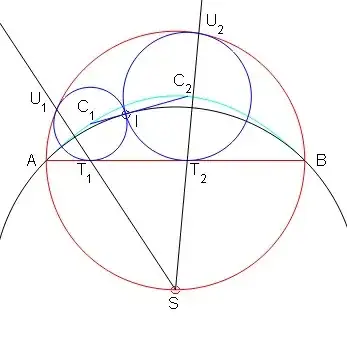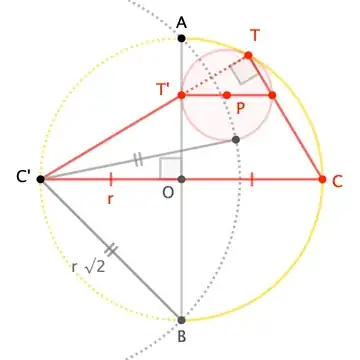In the attempt to answer this question, I was brought to another one, connected to a certain family of circles.
Consider the semicircle made of the upper half of the unit circle and the horizontal diameter with endpoints $A(-1,0)$ and $B(1,0)$.
Let us now consider the family $(F)$ of circles inscribed into this semicircle as can be seen on Fig. 1.
Fig. 1: Certain circles of family $(F).$
They can be described in a parametric way as circles
$$\text{with center} \ (x_c=-\cos a, y_c=\frac12 \sin^2a) \ \text{and radius} \ y_c, \ a \in (0,\pi) \tag{1}$$
or equivalently as circles $(C_T)$
$$\text{with center} \ \left(x_c=\frac{T^2-1}{(1+T)^2}, y_c=\frac{2T}{(1+T)^2}\right) \ \text{and radius} \ y_c, \ T \in (0,+\infty) \tag{2}$$
(Connection between the two parameterizations: $T=t^2$ where $t:=\tan \tfrac{a}{2}$).
The locus of these centers is parabola $(P)$ with cartesian equation:
$$y=\tfrac12(1-x^2),\tag{3}$$
represented on Fig. 2 as the light blue curve.
Each circle $(C_T) \in F$ is associated with a unique circle $(C_{T'}) \in F$ which is tangent to $(C)$ as depicted on Fig. 2.
Fig. 2: Two circles of family $(F)$ are mutually tangent if their parameters $T$ and $T'$ comply with relationship (4).
Let $I$ be the point of tangency of $(C_T)$ and $(C_{T'})$.
Question: how can we describe the locus of $I$?
(sketched as the magenta curve on Fig. 2.)
My work: I have obtained through tedious calculations an unexpected linear relationship between parameters $T$ and $T'$ which is:
$$T=(3-2 \sqrt{2})T'\tag{4}$$
Using (4), I have tried to obtain the locus of $I$ as the envelope of chords defined by the line segment joining the centers of circles $C_T,C_{T'}$ using homographies but to no avail.
Edit: Nice solution using inversion (a little different from the solution given in a comment by Blue).
'Refer to Fig. 3). Consider inversion with pole $S(0,-1)$ and power $2$ meaning that $M$ is exchanged with $M'$ iff $S,M,M'$ are aligned and $SM.SM'=2$. Its circle of inversion is the black circle (center $S$, radius $\sqrt{2}$). It is easy to see that any circle of family (F) is globally invariant. This is in particular the case for the two blue circles. As the image by inversion of two tangent curves in a certain point $I$ is two tangent curves with contact point $I'$ where $M'$ is the image of $M$, point $I$ is invariant, establishing that $I$ belongs to the circle of inversion.$\square$
As a consequence, tangency points $T_1$ and $U_1$, $T_2$ and $U_2$, are exchanged, meaning that $S,T_1,U_1$ and $S,T_2,U_2$ are aligned.
Fig. 3.
Remark: Two properties of circles of family (F) deserving to be known:
http://www.gogeometry.com/problem/p311_circle_inscribed_semicircle_chord.htm
http://www.gogeometry.com/problem/p310_semicircle_circle_tangent_angle.htm



